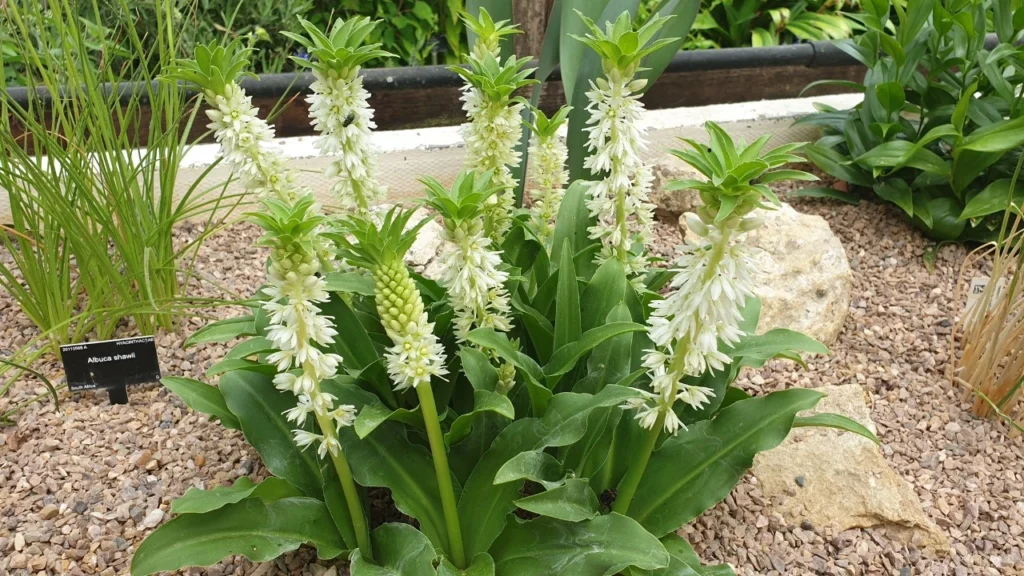Eucomis autumnalis, commonly known as pineapple lily or autumn pineapple flower, is a perennial, bulbous plant belonging to the Asparagaceae family, subfamily Scilloideae. Native to southern Africa, including countries such as Malawi, Zimbabwe, and various regions of South Africa, this plant is valued both for its ornamental appearance and its traditional medicinal applications.
The genus name Eucomis derives from the Greek “eu-” meaning “beautiful” and “kome,” which translates to “hair” or “tuft,” referring to the distinctive inflorescence that features a crown of leaf-like bracts at the top, resembling the shape of a pineapple. The specific epithet “autumnalis” indicates the plant’s blooming period, which occurs in late summer and early autumn in the Southern Hemisphere.

The pineapple lily is found in a variety of habitats in southern Africa, from mountain slopes and forest margins to open grasslands and wetlands. The species is divided into three subspecies, primarily distinguished by the shape of the inflorescence stalk:
- Eucomis autumnalis subsp. autumnalis: occurs on mountain slopes, open grasslands, and forest margins in the Eastern Cape, Limpopo Province, Zimbabwe, and Malawi.
- Eucomis autumnalis subsp. clavata: found in open grasslands and swampy areas in KwaZulu-Natal, Lesotho, eastern Free State, Mpumalanga, Gauteng, Limpopo Province, North West, and Botswana.
- Eucomis autumnalis subsp. amaryllidifolia: grows among rocks on mountain slopes in the western Free State and Eastern Cape.
These habitats range from high altitudes, where the plant is exposed to cold winters and harsh conditions, to lower, wetter areas. In addition to these subspecies, Eucomis autumnalis has been used in the development of hybrids and cultivars for gardens, along with other species in the genus, such as Eucomis comosa, Eucomis bicolor, and Eucomis pallidiflora. These hybrids aim to combine desirable traits such as variations in flower color and more ornamental foliage.

Eucomis autumnalis develops from a large, ovoid bulb, with a diameter ranging from 8 to 10 cm (3.1 to 3.9 in). Roots emerge from the base of the bulb, aiding in anchorage and nutrient absorption. The plant is acaulescent, meaning it lacks a visible aerial stem; its leaves emerge directly from the bulb in a basal rosette. The leaves are large, soft, and succulent, with wavy margins. They measure between 12 and 35 cm (4.7 to 13.8 in) in length and 6 to 7.5 cm (2.4 to 3 in) in width, forming a dense basal rosette. The leaf surface is smooth, and the color varies from light green to dark green, depending on environmental conditions.
During the blooming period, a floral stalk known as a scape emerges, reaching between 30 and 45 cm (11.8 to 17.7 in) in height, supporting the inflorescence above the foliage. The inflorescence is a dense, cylindrical spike (raceme), composed of up to approximately 125 star-shaped flowers. At the top of the inflorescence, there is a tuft of leaf-like bracts, forming a structure resembling a pineapple crown, a feature that inspired the plant’s common name.
The flowers are small, with tepals ranging in color from white to greenish-yellow. Each flower has six tepals arranged in a star shape and is supported by a short pedicel, measuring between 2 and 10 mm (0.08 to 0.39 in) in length. The flowers emit a mild, sweet fragrance, attracting pollinators during the blooming period, which occurs from mid-to-late summer.
After pollination, the flowers develop into three-lobed capsule fruits, containing small, round, glossy black seeds. The capsules may have thin, slightly inflated walls or thick, rigid walls, depending on the subspecies. The fruits remain on the plant throughout autumn, adding ornamental value even after the blooming period ends.

An interesting fact about Eucomis autumnalis is that despite its bulb being toxic, it is widely used in traditional South African medicine. Cooked bulbs are employed in the treatment of lower back pain, to aid in post-operative recovery, and to promote the healing of fractures. Additionally, they are used to treat urinary diseases, stomach pain, fevers, colic, flatulence, hangovers, and syphilis, as well as to facilitate childbirth.
In landscaping, Eucomis autumnalis is valued for its exotic appearance and prolonged blooming period. Its inflorescences, which resemble small pineapple crowns, add a tropical touch to gardens and green spaces. This plant is ideal for borders, flower beds, and container cultivation, making it an excellent choice for compositions that seek distinctive elements with low maintenance requirements. Additionally, its flowers attract pollinators such as bees and butterflies, contributing to garden biodiversity.
A remarkable characteristic of the pineapple lily is its ability to maintain an ornamental inflorescence even after flowering. Once pollinated, the flowers acquire a greenish hue and remain decorative throughout autumn, adding prolonged visual interest to the garden.
This species thrives in environments with full sunlight, although it can tolerate partial shade. In shaded conditions, blooming may be less abundant. It prefers temperate to warm climates and is sensitive to severe frost. The ideal soil is rich in organic matter, well-drained, and moderately moist. Waterlogged soils can lead to bulb rot.

During the active growth period in spring and summer, it is essential to keep the soil evenly moist, avoiding both excessive dryness and waterlogging. Watering should be reduced in autumn, following the plant’s natural senescence, and suspended in winter when it enters dormancy. Fertilization with a balanced fertilizer rich in phosphorus and potassium is recommended at the beginning of spring to promote healthy development and vigorous flowering. Removing wilted inflorescences and dried leaves enhances both the plant’s aesthetics and health.
In general, the pineapple lily is resistant to pests and diseases. However, improper growing conditions, such as poorly drained soil or excessive moisture, can predispose the plant to bulb rot. Monitoring signs of water stress and adjusting irrigation practices accordingly is crucial.
Propagation can be done through seeds or bulb division. Sowing should take place in autumn or spring, with germination occurring within a few weeks. However, the most efficient method is bulb division during the dormancy period at the end of winter. Offsets can be separated from the mother bulb and planted individually, ensuring the preservation of the parent plant’s characteristics.


